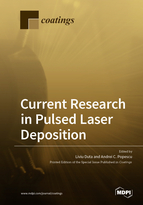Current Research in Pulsed Laser Deposition
A special issue of Coatings (ISSN 2079-6412).
Deadline for manuscript submissions: closed (10 October 2020) | Viewed by 45178
Special Issue Editors
Interests: thin films deposition; biomaterials and protective coatings; characterization methods; natural origin calcium phosphates as sustainable biofunctional coatings for medical applications; biomimetic metallic implants
Special Issues, Collections and Topics in MDPI journals
Interests: additive manufacturing; laser metal processing; biocompatible materials; surface microstructuring; deposition and modification of thin solid structures via high intensity laser irradiation
Special Issues, Collections and Topics in MDPI journals
Special Issue Information
Dear Colleagues,
We warmly invite you to submit your recent work in the field of thin film/nanoparticles synthesis by Pulsed Laser Deposition (PLD) to this Special Issue “Current Research in Pulsed Laser Deposition”.
In industry, thin films proved invaluable for protection of tools withstanding high frictions and elevated temperatures, but also found successful applications as sensors, solar cells, bio-active coatings for implants and in lithography. Other envisaged applications are currently researched for energy-storage devices, drug delivery or in situ microstructuring for boosting surface properties.
Using PLD, there are endless possibilities for tunning thin films composition and enhancing their properties of interest due to: (i) the easiness of a congruent transfer even for very complex target materials, (ii) versatility of the experimental set-up which allows for simultaneous ablation of multiple targets resulting in combinatorial maps or consecutive ablation of multiple targets producing multi-layered structures, and (iii) adjustment of the number of laser pulses, resulting in either a spread of nanoparticles, islands of materials or a complete covering of a surface. Moreover, a variation of PLD, known as Matrix Assisted Pulsed Laser Evaporation, allows for deposition of organic materials, ranging from polymers to proteins and even living cells, otherwise difficult to transfer unaltered in form of thin films by other techniques. Furthermore, the use of laser light as transfer agent ensures purity of films and pulse-to-pulse deposition allows for an unprecedented control of film thickness at the nm level.
Taking into account the wide range of PLD possible applications, this Special Issue of Coatings aims to publish state-of-the art research papers and reviews on the latest trends in laser deposition of thin films and nanoparticles. There is no restriction regarding the field of applications, as PLD is one of the most versatile techniques that can find its place in numerous research and industry fields.
In particular, the topics of interest are devoted but not limited to thin films and nanoparticles with applications for:
- Medical implants and drugs
- Sensors
- Protection of cutting and drilling tools
- Protection of aerospace modules
- Lithography
- Decorative objects
- Magnetic devices
- Superconductive appliances
- Plasmonic effects
- Catalysts
- Energy storage
The Special Issue will also cover thin film surface microstructuring, structure transformation (crystalization, amorphisation, doping), and also novel characterization techniques for thin films.
Dr. Liviu Duta
Dr. Andrei C. Popescu
Guest Editors
Manuscript Submission Information
Manuscripts should be submitted online at www.mdpi.com by registering and logging in to this website. Once you are registered, click here to go to the submission form. Manuscripts can be submitted until the deadline. All submissions that pass pre-check are peer-reviewed. Accepted papers will be published continuously in the journal (as soon as accepted) and will be listed together on the special issue website. Research articles, review articles as well as short communications are invited. For planned papers, a title and short abstract (about 100 words) can be sent to the Editorial Office for announcement on this website.
Submitted manuscripts should not have been published previously, nor be under consideration for publication elsewhere (except conference proceedings papers). All manuscripts are thoroughly refereed through a single-blind peer-review process. A guide for authors and other relevant information for submission of manuscripts is available on the Instructions for Authors page. Coatings is an international peer-reviewed open access monthly journal published by MDPI.
Please visit the Instructions for Authors page before submitting a manuscript. The Article Processing Charge (APC) for publication in this open access journal is 2600 CHF (Swiss Francs). Submitted papers should be well formatted and use good English. Authors may use MDPI's English editing service prior to publication or during author revisions.







